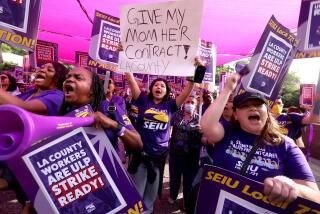Strike Vote Could Test Law’s Limits
Frustrated after three years without a raise, members of the largest state workers union are preparing for their first strike -- a series of rolling walkouts that might be illegal.
Members of Service Employees International Union Local 1000, which represents more than 87,000 of the 173,000 rank-and-file state workers, are voting through June 10 on whether to authorize leaders to call a strike. Union officers expect approval.
Workers contend they would lose ground under the state’s current offer of a 3% raise because of the rising cost of living and changes to their healthcare coverage.
Interest in a strike is fueled by lingering anger over Gov. Arnold Schwarzenegger’s failed attempts last year to change the state’s pension and budget systems through ballot initiatives. Local 1000 was part of the alliance of unions that ran a more than $100-million campaign against those measures.
“It’s just shameful that the governor has put members in a place where they are forced to do something that may or may not be legal,” said Dianne Ledebur, a union steward who works in a Department of Motor Vehicles call center in Van Nuys.
“All of us are concerned about it. But at what point do you take action?”
Negotiations took place last week, with both sides reporting progress. State officials said they were optimistic that an agreement could be reached. They also pointed out that a strike would be illegal and those walking out could face discipline.
“We are still bargaining in good faith,” said Lynelle Jolley, communications director for the state Department of Personnel Administration. Of a possible strike, she said, “I will resist speculating,” adding: “The state departments are prepared for different scenarios, whether they are natural disasters or unexplained absences.”
Local 1000 President Jim Hard vowed that the union would call a strike if there is no agreement on a new contract by June 15, the end of the current budget year.
A strike could affect the daily life of most Californians. The union represents toll collectors, tax collectors, custodians, DMV staffers and agricultural inspectors -- as well as nurses, teachers, cooks and other support staff in prisons and state hospitals. The average yearly salary for a Local 1000 member is $43,000.
In general, state workers have refrained from striking because of contracts, the law or fear that a work stoppage by government employees would bring them negative publicity. Legal precedent says unions may strike only after the formal declaration of an impasse.
Local 1000’s most recent contract with the state had a no-strike provision. And even though the contract expired in June 2005, state law says the no-strike provision and other features of the contract remain in force.
But the union points to a 1985 state Supreme Court decision that said employees of local governments have the right to strike. In the event of a strike and court fight, the union would argue that the local precedent should apply to state workers.
With no history of formal walkouts by state workers, a battle between the Schwarzenegger administration and Local 1000 could produce a new precedent and perhaps give public employee unions more leverage with the government.
“There’s going to be the need for some additional law,” said Rob Hulteng, a San Francisco lawyer who represented the University of California in an effort to head off a nurses strike at its hospitals. “There is an open issue in California about whether or not public sector employees have an unlimited right to strike.”
The strike vote began in mid-May, and union leaders have been traveling the state for informal meetings with members at venues such as the Scottish Rite Center in San Diego, a Porterville Denny’s and a Round Table Pizza in Chico. A union schedule shows 39 sessions in all.
On Thursday night, at a food workers’ union building in Camarillo, Hard showed a DVD and took questions from more than three dozen workers. Union officials also asked for volunteers to join a “flying squadron” that would agree to strike for up to four days and help organize co-workers. Volunteers were given dark blue T-shirts with a gold bird on the front. Under questions from workers, Hard laid out a plan for rolling strikes targeting different offices each day. “It’s very disruptive. They can’t plan for it,” Hard told workers. “They can’t stop it.”
In their questions and in interviews with The Times outside the meeting, workers expressed both determination to secure a raise and anxiety about the consequences of a work stoppage.
Dorie Ponio, 55, a registered nurse at a youth correctional facility in Ventura County, asked about a supervisor’s remark that workers who went on strike could be fired. ShaRan Lyons, an adjudicator at an unemployment office in Oxnard, said she had warned her adult children to be ready to send her cash if there’s a strike.
“I don’t want to strike. I don’t think anybody does,” said Jack Gross, 64, who handles disability claims. Wearing a purple bandana that made him look like the pirate he sometimes plays in seafaring reenactments, Gross added: “We have to do something.”
Hard sought to reassure workers that the union would defend them if the state attempted to punish them for any walkout. The Schwarzenegger administration has said that employees would not be paid for any time they missed and could face discipline, though officials have not given specifics.
Hard said that in the event of a strike, the union would not sign a contract unless it included amnesty for all striking workers. At the same time, he warned that he did not know if the courts would find a strike to be legal.
“This is a legal controversy,” he told the workers. “I can’t tell you the way it’s going to be resolved.”
Local 1000’s strike threat reflects a newly aggressive posture for state workers, whose contracts have long been negotiated quietly by the California State Employees Assn., an umbrella group that includes the local. As recently as 2001, the employees association president maintained in a flier sent to members that state workers could not engage in a strike.
But in recent years, Hard and other Local 1000 leaders have achieved financial independence from the association and adopted the more aggressive strategy advocated by SEIU’s international president, Andy Stern. This spring, Stern has been in contact with Schwarzenegger and his chief of staff about Local 1000, according to union and administration officials.
In March and April, Local 1000 members picketed state offices and took “solidarity breaks,” leaving their offices at the same time as a show of force. On May 8, thousands of Local 1000 members, many chanting “Strike!” rallied in front of the state Capitol.
“We’re moving from a sleepy kind of association into a movement that views the members as the basis of any union strength,” Hard said in an interview. “I don’t think SEIU Local 1000 can be ignored anymore by state government as it has been in the past.”
Privately, union officials say the strike threat has allowed Local 1000 to gain the attention of members and of state workers who pay fees for representation but are not union members.
They also attribute movement in negotiations to the strike threat. During talks last week, the state dropped a demand that workers pay more into their pensions.
More to Read
Sign up for Essential California
The most important California stories and recommendations in your inbox every morning.
You may occasionally receive promotional content from the Los Angeles Times.










